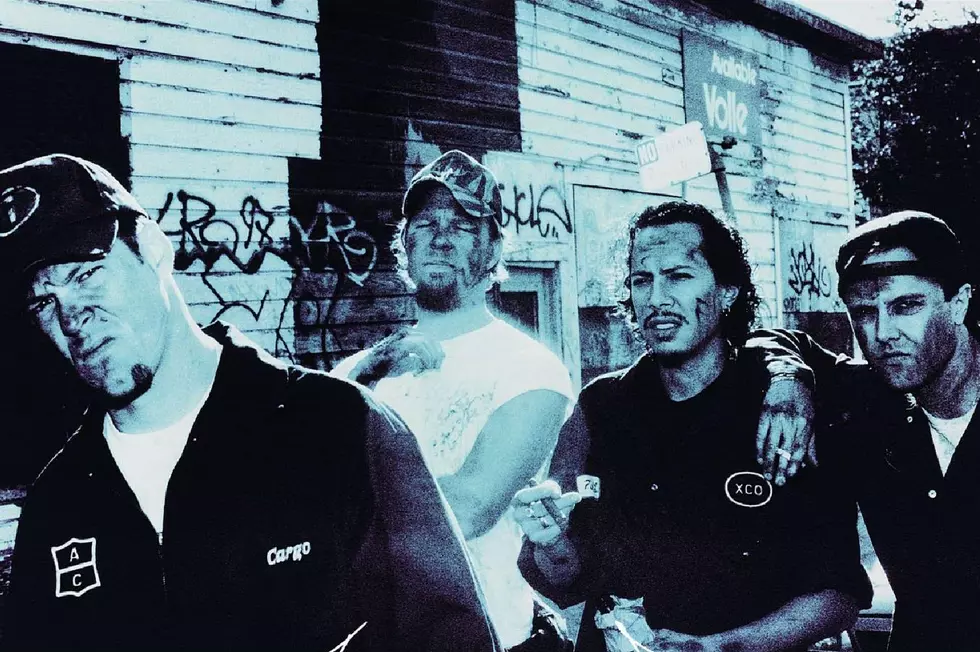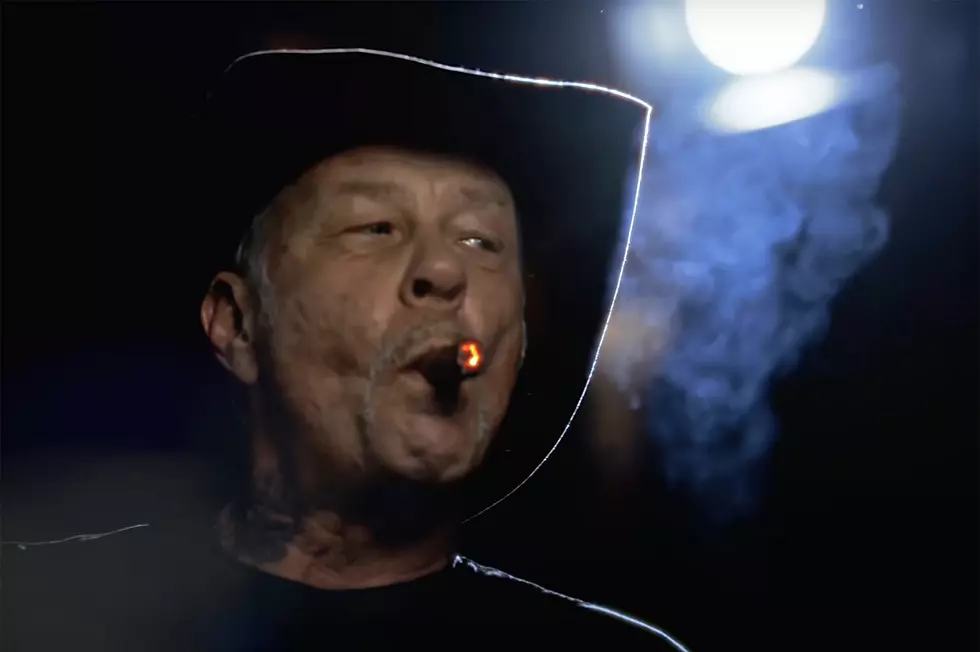
When Metallica Revisited Their Influences on ‘Garage Inc.’
Ten years removed from their prog-thrash opus … And Justice for All, things were quite different for Metallica.
A trio of chart-topping albums gained them mainstream popularity, but alienated a large degree of their original fanbase – especially with the blues and country-tinged elements on Load and Reload. Making a conscious decision to get back to their roots, the band hit the studio to record some covers in the vein of 1987’s Garage Days Re-Revisited, with the result being Garage Inc., released on Nov. 24, 1998.
“We haven't really fucked with cover songs for a while,” drummer Lars Ulrich told Metal Hammer. “But we just did the two Load albums more or less back to back, so it just seemed like a good time to do some, from both a time point of view and a creative point of view. Just shake that off a little bit and come back to something a little looser and a little kind of sillier. There was just a renewed interest in fucking with some other stuff."
Metallica had been talking about doing another Garage Days album for some time, and decamped to guitarist Kirk Hammett’s basement less than two days after the final show of the Reload tour that September. They would figure out what songs each member was going to bring in and work on three or four each day. One goal was to keep the sessions loose, they also wanted to retain a level of enjoyment in recording the music.
“The most important thing about this, really, is the ‘fun’ factor,” bassist Jason Newsted said. “Not having to get, like, in the Metallica recording mode of everything has to be under such a huge microscope and everything has to be so perfect. This thing gets to be raw and rough and fun…sloppy like it should be – like rock and roll should be. It’s very much rock and roll, that’s the cool thing.”
“It was a lot more spur of the moment stuff, a lot more vibe,” frontman James Hetfield added. “Definitely a lot more fun.”
The idea was to blend an album’s worth of new covers with all those that had been released previously on B-sides, and the Garage Days Re-Revisited EP, making for a double album that effectively spanned Metallica’s career. The songs they’d chosen over the years, in one respect, were a way to pay back the artists whose coattails Metallica had ridden in their club days, when they were filling out their sets with covers of obscure British bands the audience likely didn’t know, passing them off as their own compositions.
Watch Metallica Perform 'Turn the Page'
“We took their songs and called them ours,” Hetfield said, laughing. “’Metallica Live Tonight at the Troubadour,” – half the set is Diamond Head. But no one knew and they didn’t care and we didn’t tell ‘em. So we do owe [the original artists] somethin’.”
“We’re definitely wearing our influences on our sleeves with this one … again,” Hammett added. “This album’s a bit autobiographical in a musical sense, ‘cause these are all bands that have been such a huge inspiration to us and a huge influence on us. By listening to this album, you can tell where we got a lot of our ideas really. These are some of the most influential bands in Metallica’s career.”
The first half of the album was 10 new covers that were more exploratory than anything they had attempted in the past. It was bookended with a familiar take on hardcore punk, taking a pair of songs by the English outfit Discharge with the lyrically concise “Free Speech for the Dumb” (where the title is the only words) and “The More I See,” the latter with a hidden track of sorts, a bit of Robin Trower’s “Bridge of Sighs.”
Also included were homages to acts that were well-known to have aroused musical stirrings in Metallica like the Misfits (“Die, Die My Darling"), Black Sabbath (“Sabbra Cadabra” blended with “A National Acrobat”), Diamond Head (“It’s Electric”) and a masterful fusion of Mercyful Fate’s "Satan's Fall," "Curse of the Pharaohs," "A Corpse Without Soul," "Into the Coven" and "Evil" into an 11-minute medley. Less expected were nods to Blue Oyster Cult (“Astronomy”) and when the band took on Thin Lizzy’s version of the traditional Irish folk song “Whiskey in the Jar.” There’s also a head-scratcher of a choice in doing gothic rock poster boy Nick Cave’s “Loverman,” but even when an oddity is put into a new frame by Metallica, it somehow works.
“We put all these songs on the table, digested them and spit them out Metallica-style,” Hetfield said. “There’s only so much you can mess with the sounds, you know?”
The lead single for Garage Inc. made both the most and least sense. The band identified with the lyrics to Bob Seger’s “Turn the Page,” about the lonely life on the road for musicians in towns where they perpetually feel like outsiders. It was a song that Ulrich had never really paid attention to until a chance tuning in while driving over San Francisco’s Golden Gate Bridge had him listening to it from another point of view where he realized it was the perfect song for Hetfield to sing. Still, it was Bob Seger, and the majority of Metallica were far from fans of the heartland rocker who was a mainstay on rock radio beginning in the mid-'70s.
“Actually, I can’t stand Bob Seger,” Hetfield said. “I’ve never met him, so nothing really against him, but growing up the radio, [sings] ‘Take them old records off the shelf,’ that’s all I ever heard on the radio. I was like, ‘Play some Aerosmith or something.’ I would just turn the radio off – it would just drive me up the wall. It was more the song, the song – and lyrically especially – it belonged to Metallica. ‘On the road again,’ and we’re the road dogs…it’s the one song we can really relate to.”
“Turn the Page” ended up becoming one of Metallica’s biggest hits, holding onto the top spot on Billboard’s Mainstream Rock Songs chart for 11 weeks.
Listen / Watch Metallica Perform 'Whiskey in the Jar'
The one quirk on the Garage Inc. side of new music was the inclusion of Lynyrd Skynyrd's “Tuesday’s Gone,” which was taken from a radio show in Dec. 1997 where Metallica did an eight-song acoustic set with various guest musicians. Assistance was provided by Jerry Cantrell and Sean Kinney from Alice in Chains, Jim Martin from Faith No More, Les Claypool of Primus, John Popper from Blues Traveler, Pepper Keenan of Corrosion of Conformity and Skynyrd’s Gary Rossington. Remixed for the record to remove the roughness of the radio broadcast, it still feels a little out of place.
The second half of Garage Inc. was all previously released material, freshly remastered, kicking off with the Garage Days Re-Revisited EP and the original Garage Days Revisited, which was the two B-side songs on the 1984 “Creeping Death” European single, covers of Blitzkrieg’s “Blitzkrieg” and Diamond Head’s “Am I Evil?” That was followed by a handful of songs that had appeared on Metallica singles and compilations during the …And Justice for All and Black Album eras; Budgie’s “Breadfan,” Diamond Head’s “The Prince,” Queen’s “Stone Cold Crazy,” Anti-Nowhere League’s “So What” and Sweet Savage’s “Killing Time.”
The final section was titled “Motörheadache” a collection of four Motorhead songs the band recorded in Dec. 1995 when they were rehearsing for a performance at Lemmy Kilmister’s 50th birthday celebration. The tracks also appeared on the 1996 U.K. single for “Hero of the Day” from Load. It’s also worth noting that "The Chase Is Better Than the Catch” and “We Are the Road Crew” were also recorded at the 1995 sessions – and played at Lemmy’s party – but have yet to see the light of day.
The liner notes in Garage Inc. had a lengthy essay by writer David Fricke, as well as a list of often humorous alternate titles for the collection which had been bandied about in the compact-disc inlay tray. (It also served as the cover image for the “Turn the Page" single.) Among the discarded names were Exile on Garage St., Use Your Garage I & II, Dark Side of the Garage, Garage ‘Em All, Magical Mystery Garage and The Garage Remains the Same. It was that last one which would be the name of the tour in support of the record which went through the summer of 1999.
The tour launched with a special five-date promo run for Garage Inc. dubbed “Garage Barrage” where Metallica played a full set of covers in Toronto, Chicago, Detroit, Philadelphia and New York City at much smaller venues, mostly in the 3,000 person capacity range. The New York show at Roseland Ballroom was filmed and later broadcast on MTV as ‘Metallica: Live Covers.’
20 Greatest Comeback Albums
Why John Bush Turned Down Metallica
More From Ultimate Classic Rock









